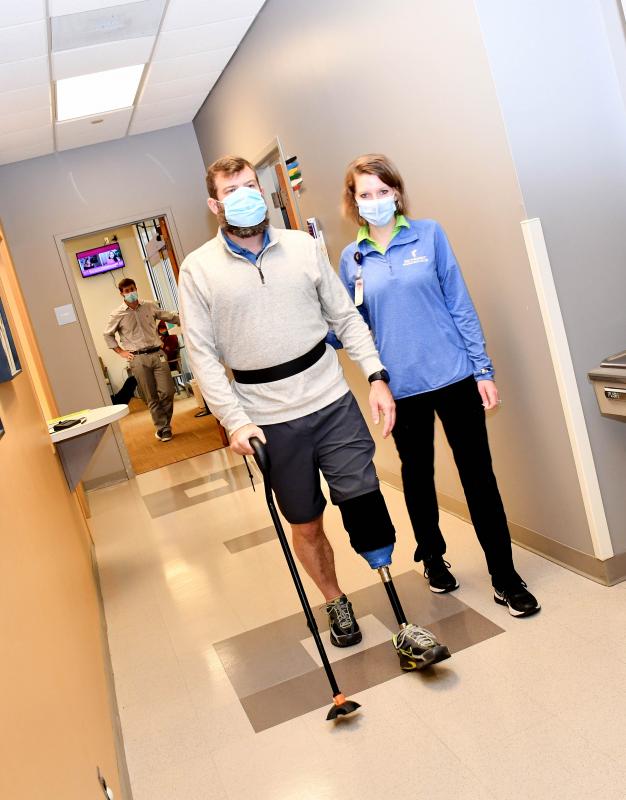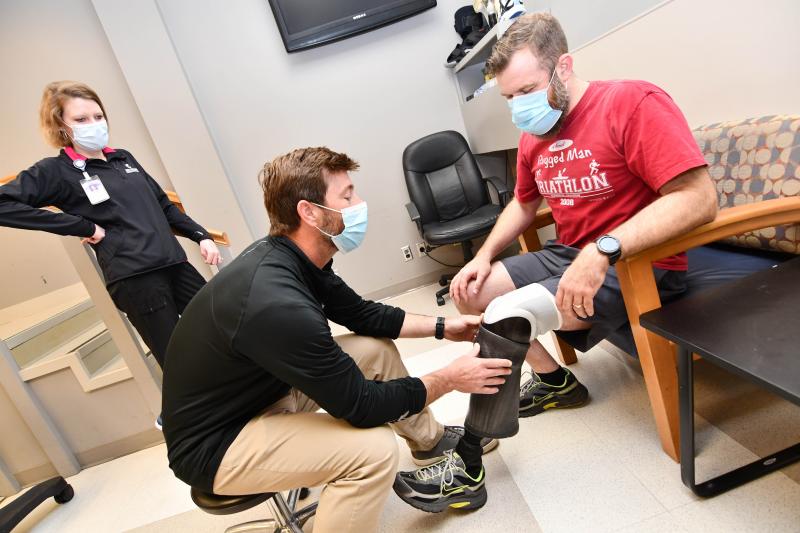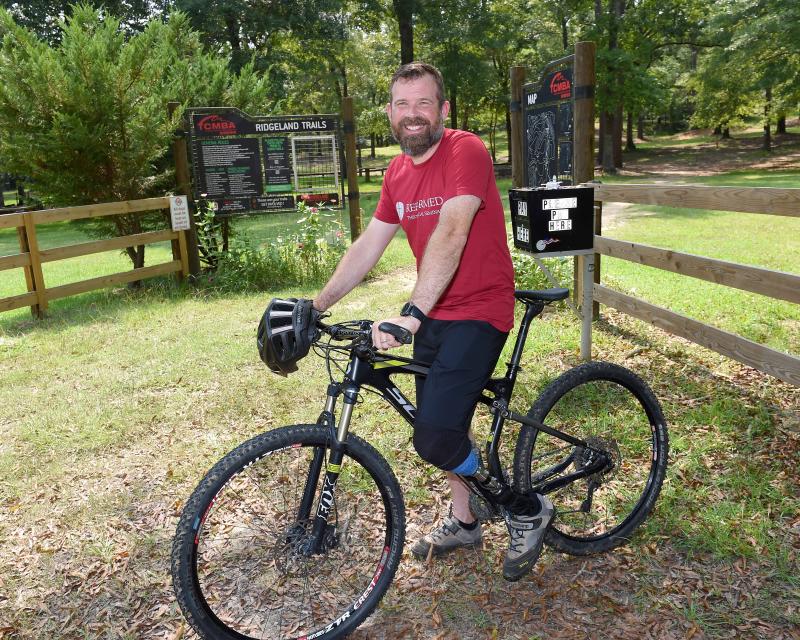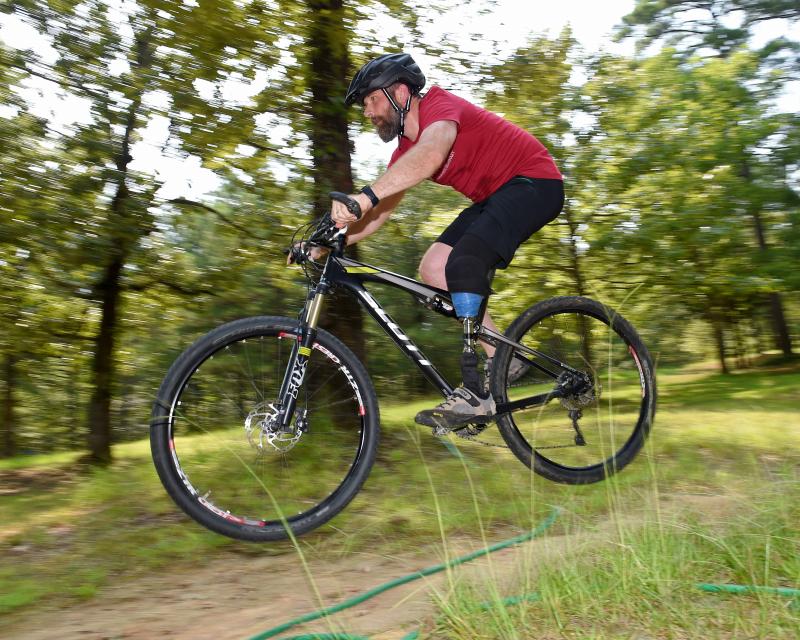When Stephen “Step” Morgan wrecked his bike at the Ridgeland Trails, he knew he was hurt. But he had no idea his life was forever changed.
“At the time of my crash, I was sitting there waiting for help, thinking I was going to have to preach from a stool in a cast that Sunday,” said Morgan, who is director of admissions at Reformed Theological Seminary in Jackson and preaches regularly at area Presbyterian churches. “I had no idea that my life was in danger.”
And he certainly had no idea that he’d soon have his left leg amputated below the knee and be learning to walk again using a prosthesis at Methodist Orthotics & Prosthetics in Flowood. Or that with continued rehab at Methodist Outpatient Therapy at the same facility, he would be back riding on those trails less than five months after his injury.
“They told me I would be able to do anything I wanted to do with time,” Morgan said. “My experience with Methodist was just fantastic.”
Morgan says he was an experienced mountain bike rider when his accident occurred on October 23.
“I had been riding out there two to four times a week, and had gotten very familiar with the trails,” he said.
He had been working on mastering one of the trails’ newer obstacles.
“They’re wooden platforms called drops,” Morgan said. “One was about a foot and a half tall, and the other was about three feet tall. You ride off them and you land on sloping ground, so the impact is minimal and very smooth. I wanted to work my way up to the bigger drop, so I had ridden the smaller one maybe 150 times before.”
But on this day, as he was coming off that same drop, his left riding shoe came unclipped from his pedal and he wrecked. He landed left leg first, which shattered his tibia and punctured his popliteal artery.
“I yelled for help and a couple of riders were by my side within a minute or so,” Morgan said. “But I was about a quarter mile up the hill from the trailhead, so it took EMS a while to arrive. Then, we had to wait for the fire department to get an ATV up there to get me out. So it took about an hour between my crash and when they loaded me in the back of the ambulance.”
Because of the damage to his artery, Morgan lost a large amount of blood before he could make it to the ER at the University of Mississippi Medical Center. Doctors did what they could to try and save his leg with surgery, but over the following days he had four more surgeries as his leg began to deteriorate. Ultimately though, the muscle tissue in his leg began dying due to the blood loss and it was necessary to amputate.
“I knew I had faith, and that meant God was at work, and that He would shepherd me through this,” Morgan said. “The idea of an amputation was of course not something that we welcomed, but we trusted that God would take care of me.”
Morgan’s wife, Jessica, shared his story via social media and asked for people to pray for him. When she shared the latest news, Morgan’s spirits were lifted by people from his greater church community that contacted him to share their experiences of life after amputation.
“Lots of people reached out to assure me that there were many amputees right here in our area that have very active lives,” he said. “I was not very familiar with prosthetics or what life was like for amputees.”
Morgan’s sixth surgery was the amputation, exactly a week after his accident. In all, Morgan was in the hospital for 15 days, and underwent four more surgeries to fight off infection at the amputation site.
“It was quite an experience, but I had a great care team at the hospital there at UMMC,” Morgan said.
When he was discharged, Morgan was given the choice of going to inpatient rehab at Methodist Rehabilitation Center, or going home first, then going to outpatient therapy later.
“At the time, I didn’t understand the benefits of inpatient vs. outpatient rehab,” Morgan said. “I thought, ‘I want to see my kids, of course I want to go home!’”
Morgan is the father of five, and missed his wife and their children Rachel Katharine, 19, Samuel, 17, Sophie, 14, Noah, 11, and Eli, 8. But he acknowledges that delaying rehab at Methodist Outpatient Therapy in Flowood until the week of Thanksgiving may have set him back.
“When I first started physical therapy, I could only bend my left knee about 33 degrees,” Morgan said. “To be able to use a prosthesis effectively, I needed to be able to bend it to 90 degrees.”
So physical therapist Karen Klein was tasked with helping him regain that range of motion so he could eventually be fitted with a prosthesis.
“From the beginning, he could barely bend his knee,” Klein said. “It was stuck. We also had to protect his fracture so it could heal. It wasn’t a matter of just waiting for his incision to heal like most amputees. His leg was very swollen at first. So we focused on decreasing the swelling using the tools we had, like manual therapy and the Hivamat, to gain range of motion. His scar tissue was severe, too, because he had so much trauma.”
The Hivamat is a therapeutic device that utilizes electrostatic waves to create a kneading effect deep within damaged tissues, rapidly relaxing muscles, alleviating pain and reducing swelling. It also helps restore flexibility and blood supply to the affected area.
“Early therapy intervention was of utmost importance for Step to be able to use a prosthesis,” Klein said. “Once his swelling and scar tissue were manageable, we saw gradual then steady improvements. And he was so compliant and did everything I asked of him. I remember how excited he was the day we finally got his kneecap to dislodge, and we doubled his knee flexion from like 30 to 60 degrees. But that still wasn’t enough. So we worked through it to get to 90 degrees, and he was soon able to get his prosthesis.”
Certified prosthetist Taylor Hankins worked with Morgan to build a prosthesis that fit his needs.
“When he came to us, I knew his story, because I mountain bike at the same place where he was injured,” Hankins said. “I was really hoping to get to work with him. I knew he would want to get back to being active, whether it was mountain biking or anything else. I wanted to talk with him about options, about how he was not limited by his amputation and could be just as active as he was before.”
Hankins came up with some initial solutions that would accommodate Morgan’s limited range of motion like an articulating ankle that allowed his foot and toe to clear the ground when stepping.
“That encouraged his knee flexion, and with physical therapy it helped increase his range,” Hankins said. “Then, as he got more and more range, we could change the foot out with something that had a higher spring efficiency to give him some energy back and do even better in therapy.”
“Taylor was just fantastic,” Morgan said. “The process was just super smooth in terms of the coordination between physical therapy and them building a prosthesis.”
Klein said that having O&P next door allows for greater teamwork.
“Every time Step was in the therapy, Taylor was willing to come over and adjust things if needed,” she said. “With every gain Step made in therapy, it changed the way it affected his prothesis. So I think he hugely benefited from us being a one-stop shop.”
But even though he now had a working prosthesis, Morgan was limited to only wearing it two hours a day at first.
“What was left of my tibia was still healing,” Morgan said. “We had to be very careful not to reinjure my leg. Karen had to be very strategic about the exercises she chose for me.”
“Step was the kind of guy to overdo it,” Klein said. “I was encouraging him to follow the doctor’s orders. He was wanting to go above and beyond. So I was leaning on the side of caution, and we had to find a happy medium. We were very creative finding effective but safe strengthening exercises and techniques.”
As Morgan made more gains in therapy, and as his leg continued to heal, he gradually became a skilled prosthetic user.
“After my surgeon cleared me to be full weight-bearing on my leg, we just really took off,” Morgan said.
Soon Klein had Morgan going up and down stairs, walking sideways and doing other high-level activities.
“He could even lightly jog within that first month, which is pretty phenomenal,” Hankins said. “It takes some time to get used to a prosthesis. But he was gaining balance, strength and stamina quickly.”
By April, Morgan had finished his physical therapy and Hankins began to build him a final prosthesis.
“We tried a few things that worked and some that didn’t,” Hankins said. “We settled on an energy-storing, carbon-fiber foot component. On top of that is a shock rotation and torsion adapter that absorbs some of the impact from walking, but mostly the shock of higher impact activities like running and sports. It works really well for something like mountain biking.”
Morgan says he’s been pleased with the versatility the prosthesis allows.
“I can play with my kids in the yard, I can even run on it a little,” Morgan said. “And I’m riding my mountain bike again with this leg.”
Morgan says he’s been back to the trails several times. And he’s even done the drop that changed his life.
“I knew from the outset that I wanted to ride again, for multiple reasons,” Morgan said. “For one, it brings me so much joy. I love mountain biking. And two, that place and my fellow riders there had become very special to me. So I didn’t want to lose that community. And then three, I didn’t want it to beat me. I wanted to get back on the bike and not be stopped by my injury.”
Morgan has also returned to his job at Reformed Theological Seminary and traveling regularly to recruit students. He was a student himself while working there and graduated in May 2020. He says he had even been looking for a job.
“My long-term desire is to be a pastor, and we were actually in the process of finding me a ministry when my accident happened, so we put that on hold,” Morgan said. “I would love to be a minister, and I think that’s still the road that I’m on. I anticipate that I will eventually find a call that’s a good fit for me and my family.”
After all he’s been through, Morgan feels like the experience has strengthened his faith and his life’s calling.
“It’s given me first-hand experience of God’s faithfulness and caring for us even through difficult, unwanted circumstances and suffering,” Morgan said. “The reality is everyone suffers, and we all look for something to sustain us through that suffering and provide comfort. So it’s provided me new opportunities for me to share the hope that is offered to us in the gospel of Jesus Christ.”




